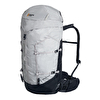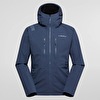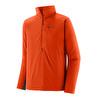Marc-André Leclerc free solo of the Tomahawk - Excocet routes in Patagonia

 1 / 3
1 / 3 Marc-Andre Leclerc
Marc-Andre Leclerc
Leclerc has now returned to Patagonia where he has made another important solo ascent, this time up Aguja Standhardt via a combination of the Tomahawk and Excocet routes. Leclerc arrived in Patagonia towards the end of the austral winter and, wasting no time, made a trip into the Torre valley to cache some gear at the Niponino camp before returning to El Chalten. Two days later he returned to deposit a second gear cache, and then he rested for few days to enable his inflamed knee to recover.
On 20 September, the last day of the calendar winter, he set off from El Chalten once again and made his way to the Niponino camp under blue skies seeing that the considerable weather window had arrived as forecast. The next day he made a somewhat difficult ascent up to the El Boquete pass, from where he could finally eye one of his main objectives, Supercanaleta on Fitz Roy. Since conditions looked thin he decided to climb the South Face of Cerro Pollone the next morning; he quickly made it to the summit ridge but rime ice stopped him from reaching the East summit and so he abseiled off prior to taking another rest day. Weather conditions were perfect and this waiting around was, as he himself describes it "likely the mental crux of my whole venture!"
After resting Leclerc set off at 4:30am from the Niponino Camp towards Aguja Standhardt and the Exocet climb. En route though he opted to start up Tomahawk; first climbed in 1994 by Conrad Anker and Steve Gerberding, this leads up the lower buttresses of Aguja Standhardt and although technically more difficult, it nevertheless looked more appealing than walking up a crevassed glacier without a belay.
Leclerc climbed quickly, climbing blocks up to 80m high (the length of his rope), then placing a pin or an ice screw to haul his pack. Tomahawk’s characteristic chimney was climbed with his pack on and this was described as "a technical and highly enjoyable pitch". This gave way to moderate snow ramps which, in turn, led to the junction with Excocet. The ground steepened at the start of the chimney and Leclerc stopped briefly for food, before continuing upwards. He commented later "As I started into the chimney I found the ice to be of generally good quality, as the sun being further to the north than in summer, did not reach the back and affect the ice." Four 80m pitches took him to a slab that barred his way from the summit ridge, but this too was climbed without needing a belay. The summit rime mushroom was stood on by furrowing his way through a narrow tunnel, exactly 12 hours after having set off.
Conditions began to worsen and he immediately began his descent. Since he was armed with just one 80m rope (instead of the usual two 60m ropes) at times he was forced to stop and make his own anchors. The descent proved relatively straightforward - apart from one brief heart-stopping moment when an in-situ nut began to work itself out of the crack - and he reached the glacier at around 8pm, just before dark, returning safely to the Niponino camp two hours later.
Commenting after his ascent, Leclerc stated "Despite being tired from my long day, I had a hard time falling asleep. I replayed the days’ events again and again in my mind, and marveled at my luck with weather, conditions and timing. The route was undoubtedly one of the highest quality ice outings I had ever climbed, and it had been such a cool experience to climb it onsight-free solo with the entire Torre Valley to myself."
It is worth remembering that in November 2010 Colin Haley carried out the first solo ascent of Cerro Standhardt via the Exocet route.
For the detailed trip report and portfolio about the ascent check out www.marcleclerc.blogspot.com
| Expo.Planetmountain | |
| Arc'teryx | |
| Petzl | |
| www | |
| FB Patagonia Vertical | |
| www.pataclimb.com | |
| FB Marc Andre Leclerc | |
| www.marcleclerc.blogspot.com | |



 Copia link
Copia link
























